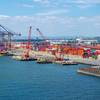Addressing a projected increase in waterborne commercial vessel traffic that is expected to double or triple over the next 20 years, U.S. Secretary of Transportation Rodney E. Slater issued a major report, An Assessment of the U.S. Marine Transportation System, outlining recommendations to meet the growing challenges to the nation's marine transportation system (MTS).
The recommendations include improved vessel traffic management to ensure safety and greater focus on operational efficiencies, research and intermodalism, and better coordination and development of adequate financing mechanisms to ensure the growth of seaports and waterways.
"The MTS is the lifeline that links American producers, farmers and manufacturers to global markets," said Secretary Slater. "Today we take the unprecedented step of presenting a coordinated public and private sector blueprint for modernizing the MTS infrastructure to make sure we are ready to compete in the global economy of the 21st century."
Maritime Administrator Clyde J. Hart and Admiral James M. Loy, Commandant of the USCG, co-chaired the national task force, which produced the report. The task force included representatives of vessel operators, shippers, ports, recreational boaters, environmentalists, shipyards, labor and other organizations. Representatives of local, state and regional governments, as well as numerous federal agencies also participated.
The President's Commission on Critical Infrastructure noted in its October 1997 Critical Foundations report the nation's maritime infrastructure is comprised of 1,900 deep draft terminals and 1,700 shallow draft terminals.
To meet this challenge, MarAd and the USCG held seven listening sessions around the country to gather input. In November 1998, Secretary Slater hosted a national conference comprised of public and private stakeholders to begin shaping a bold, shared vision for the system's future.
The recommendations in the report include:
· Creation of an MTS National Advisory Council to provide a structured approach for non-federal stakeholders to provide input on national-level issues. Secretary Slater said he would act promptly to establish such a council.
· Adopt a systematic approach to MTS safety and environmental protection. Managers, operators and users of the waterways and facilities, the landside transportation system, environmental interests and the public all must be involved via local committees or planning groups.
· Better coordination and development of adequate financing mechanisms to ensure the growth of seaports, waterways and their intermodal links. Industry and government at all levels must explore innovative funding mechanisms to leverage existing resources and make more effective use of existing funds.
· Improved efficiencies in the movement of people and cargo, including one-stop shopping for federal inspection and reporting, improved landside access to ports, a national cooperative MTS research program and more reliable traffic forecasting.
· Establishment of information management systems and infrastructure supportive of the MTS, including development of better hydrographic and weather information; improved vessel, cargo and passenger tracking methods; and better waterway traffic management information for mariners and ports.
Subscribe for
Maritime Reporter E-News
Maritime Reporter E-News is the maritime industry's largest circulation and most authoritative ENews Service, delivered to your Email five times per week









